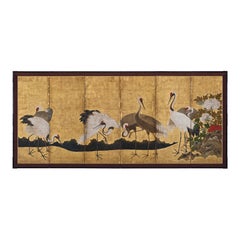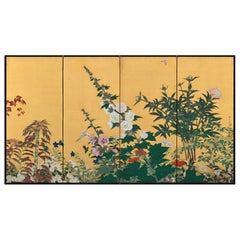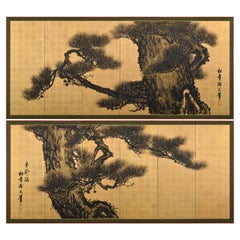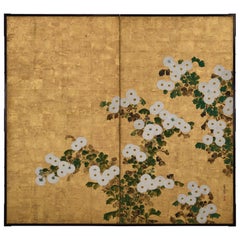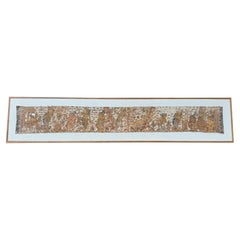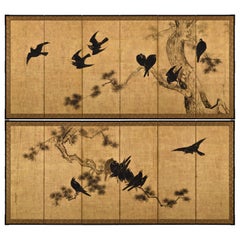Asia - Paintings and Screens
to
3
331
1,083
450
235
94
2
30
9
1
1
45
81
109
96
39
19
12
2
2
9
2
6
9
6
3
157
154
114
104
89
314
286
240
40
12
331
291
305
29
4
3
2
1
Item Ships From: Asia
17th Century Japanese Screen. Cranes and Peonies. Edo period.
Located in Kyoto, JP
Cranes and Peonies
Anonymous, Kano School.
Edo period, second half of the 17th century.
Six-panel Japanese screen. Ink, pigment gofun and gold leaf on paper.
This Japanese screen...
Category
Mid-17th Century Japanese Edo Antique Asia - Paintings and Screens
Materials
Gold Leaf
Early 20th Century Japanese Screen. Flowers of the Four Seasons.
Located in Kyoto, JP
Anonymous
Flowers of the Four Seasons
A four-panel Japanese screen. Ink, gofun and pigments on gold leaf.
This Japanese screen is a rich visual celebration of the flowers of the fo...
Category
Early 20th Century Japanese Taisho Asia - Paintings and Screens
Materials
Gold Leaf
Circa 1900 Japanese Pine Screen Pair. Aged Dragons by Suzuki Shonen.
Located in Kyoto, JP
Suzuki Shonen (1848-1918)
Aged Dragons
A pair of six-panel Japanese screens. Ink and gold leaf on paper.
Dimensions: Each Screen: H. 170 cm x 378 cm (67" x 149")
As with the pair...
Category
Early 20th Century Japanese Meiji Asia - Paintings and Screens
Materials
Gold Leaf
18th Century Japanese Rinpa Screen. White Chrysanthemums. School of Korin.
Located in Kyoto, JP
School of Ogata Korin
White Chrysanthemums
18th Century, Edo period.
A two-panel Japanese screen. Ink, color, gofun and gold leaf on paper.
Dimensions: H. 171 cm x W. 188 cm (67.5” x 74”)
On this two-panel Japanese screen we see blooming chrysanthemums, a flower which embodies the essence of autumn in Japan. Here the traditional floral theme has been simplified and stylized. The bright colors and asymmetrical composition against the delicate gold leaf create a luxurious and ornate work of art. Its background, a strikingly patinated grid of gold leaf, denies any sense of place or time and imbues everything with an ethereal glow. The leaves and stems of the plants are nothing more than pools of mottled color and ink without any outline whatsoever. These are typical Rinpa adaptations of traditional ink painting methods; tarashikomi, or diluted washes of color blended while very wet, and mokkotsu, or “bonelessness,” which creates forms without exterior outlines. The relief work of the rounded flower petals has been obtained by the moriage process (a mixture based on ground shells modeled on the surface of the paper).
On the lower right of the screen, the siganture “Hokyo Korin Jakumyo” and the “Hoshuku” seal can be read. Korin is Ogata Korin, famed for the Irises (Nezu Museum) and Red and White Plum Blossom (MOA Museum of Art) folding screens, both National Treasures. Korin worked in both Kyoto and Edo in the mid-Edo period. Korin was using the art name “Jakumyo” just after he received the Hokyo level, which was in 1701.
This particular screen was published in May of 1961 in the Japanese Sansai Fine Art Magazine*. An in depth article accompanies the photograph of the screen and and a photograph of the signature and seal. This article devotes much of its body to discussing the moriage technique, how it enlivens the chrysanthemum flowers and Korin’s specific skill in using the technique. The article goes on to discuss the most famous works of Korin, utilizing this technique, which were known at the time. Specifically a two-panel screen held in the Honolulu Museum which was discovered in the store-house of Takahashi Soan. A two-panel screen pair which the Nakano family own. A two-panel screen pair with chrysanthemums in moriage in fan designs owned by the Nomura family. Also a small folding screen featuring chrysanthemums held in the Yamato Bunkakan. The article goes on to say that this particular two-fold screen came from the Nijo family. Korin is known to have had a strong connection with the aristocratic Nijo family. The article explains that Korin received a lot of favors from the Nijo family and that this screen would have been gifted to them.
Since that time the Honolulu screen has been amended to ‘attributed to Ogata Korin’ and I do not know further details of the other 3 screens. Other Chrysanthemum screens...
Category
18th Century Japanese Edo Antique Asia - Paintings and Screens
Materials
Gold Leaf
Bali Hindu Textile Framed 'Kamasan' Painting, Indonesia C. 1900
Located in Jimbaran, Bali
This Antique Balinese Kamasan painting, rendered on handwoven cotton, beautifully captures the timeless elegance of classical Wayang-style storytellin...
Category
Early 1900s Balinese Folk Art Antique Asia - Paintings and Screens
Materials
Cotton, Paint
Mid 18th Century Japanese Screen Pair. Crows & Pines by Unkoku Toshuku.
Located in Kyoto, JP
Unkoku Toshuku (1722-1779)
Crows and Pines
A pair of six-panel Japanese Screens. Ink and gold leaf on paper.
Dimensions: Each Screen: H. 170.5 cm x W. 375 cm
Haha-cho or mynah birds, whose forms resemble crows in artwork, were commonly depicted in Japanese art. These types of paintings were originally modeled on paintings attributed to the 13th century Chinese painter Muqi (Mokkei), whose art was enormously influential in Japan. Crows only became a theme among Japanese artists from the later 1500s onward. They likely were inspired by these imported Chinese paintings of myna birds, which are not native to Japan, substituting the native species of crow instead.
The best known early examples of the depiction of Japanese crows are two Momoyama screen...
Category
Mid-18th Century Japanese Edo Antique Asia - Paintings and Screens
Materials
Gold Leaf
Early 20th Century Japanese Nihonga Screen. Bamboo Forest.
Located in Kyoto, JP
Anonymous
Bamboo Forest
Early Taisho era. Circa 1910-1915.
Six-panel Japanese Screen. Mineral pigment, gofun and ink on silk.
A six-panel Japanese folding screen, painted on silk in...
Category
Early 20th Century Japanese Taisho Asia - Paintings and Screens
Materials
Silk
Circa 1925. Taisho era Japanese Nihonga Screen. Camellia & Bamboo.
Located in Kyoto, JP
Anonymous
Camellia & Bamboo
Taisho era
Two-panel Japanese Screen. Mineral pigment, gofun and ink on silk.
A small Japanese Nihonga screen capturing...
Category
Early 20th Century Japanese Taisho Asia - Paintings and Screens
Materials
Silk
Unique Contemporary Abstract Screen Painting inspiration from the Gutai art
Located in Fukuoka, JP
Unique Contemporary Abstract Screen Painting
A one-of-a-kind contemporary abstract painting executed on a folding screen, drawing bold inspiration from the pioneering Gutai art mov...
Category
20th Century Japanese Asia - Paintings and Screens
Materials
Acrylic, Wood, Paper
Edo period Japanese Screen. Tiger and Pine by Kishi Ganku.
Located in Kyoto, JP
Kishi Ganku (1749/1756-1838)
Tiger and Pine
A six-panel Japanese Screen. Ink on silver leaf.
The central focus of this Japanese screen is a large tiger, emerging from shadow, crou...
Category
Late 18th Century Japanese Edo Antique Asia - Paintings and Screens
Materials
Silver Leaf
Early 20th Century Japanese Cherry Blossom Screen by Kano Sanrakuki
Located in Kyoto, JP
Cherry Blossoms
Kano Sanrakuki (1898-1981)
Showa period, circa 1930
2-panel Japanese Screen
Color, gofun and gold leaf on paper
Against a backdrop of gold-leafed ground, the lichen covered trunk and branches of the life-sized cherry blossom tree reach out and beyond the confines of the pictorial surface. The overall composition has a feeling of flatness which draws emphasis to the surface and the three-dimensionality of the cherry blossoms. Painstakingly built-up layers of thickly applied shell-white gofun detail the voluminous blossoms and cover large areas of this tour-de-force of Japanese Nihonga painting. By simplifying the background, minimizing the number of colors and depicting the blossoms with such heavy relief, the artist has emphasized the stunning presence of the cherry tree. The type of tree depicted is the Yae-Zakura; a double-layered type of cherry blossom famed for its beauty and strength. When we think of Japanese cherry blossoms, the first thing that comes to mind is Somei Yoshino variety, which has a single flower with five almost white petals. This type is fragile and easily blown away by strong wind or rain. Most of the double-flowered cherry blossoms begin to bloom when the Somei-Yoshino falls, and the flowering period lasts longer than that of the Somei-Yoshino.
Kano Sanrakuki originally studied painting at the Kyoto City Arts and Crafts School under the tutelage of Yamamoto Shunkyo...
Category
Early 20th Century Japanese Showa Asia - Paintings and Screens
Materials
Gold Leaf
19th Century Japanese Shunga Hand-Scroll, Katsukawa School
Located in Kyoto, JP
Shunga
Unknown artist
Meiji era, circa 1880
Hand-scroll mounted with 12 paintings
Ink, pigment and gofun on silk
Dimensions:
Each image measures H. 23.2 cm x W. 34.4 cm (9.15” x 13.5”)
The hand-scroll measures H. 28 cm x W. 540 cm (11” x 212”)
A set of 12 late 19th century Japanese Shunga paintings mounted as a hand-scroll. Two of the leaves bear the signature and seal ‘Setsuzan’, although we are unable to confirm the identity of the artist using this art name. 6 of the 12 images are taken almost directly from Katsukawa Shuncho’s late 18th century woodblock series, ‘Erotic Pictures...
Category
Late 19th Century Japanese Meiji Antique Asia - Paintings and Screens
Materials
Silk
Early 19th Century Japanese Screen. Cherry Blossom & Pheasants by Mori Tetsuzan
Located in Kyoto, JP
Mori Tetsuzan (1775-1841)
Pheasants and Cherry Blossoms
Two-fold Japanese screen. Ink, color, gofun, gold and silver on paper.
A two-fold Japanese bir...
Category
Early 19th Century Japanese Edo Antique Asia - Paintings and Screens
Materials
Gold Leaf
Mid 19th Century Framed Japanese Painting. Mice & Millet
Located in Kyoto, JP
Obata Tosho (1812-1886)
Mice & Millet
Late Edo period, mid 19th Century
Framed Japanese Painting. Ink and color on paper.
Individually framed 19th century bird and flower paintin...
Category
Mid-19th Century Japanese Edo Antique Asia - Paintings and Screens
Materials
Paper
19th Century Japanese Screen, Deer in Spring, Maruyama Shijo School
Located in Kyoto, JP
A six-panel Japanese folding screen from the leading Maruyama-Shijo artist Okamoto Toyohiko (1773-1845). Simply featuring three deer and a few sprigs of foliage on a sumptuous gold-leaf background this work emphasizes naturalistic expression and a masterful use of negative space. Reduced to its most basic elements, the blank spaces inspire imagination and evoke the smells, sounds and even the weather of the scene. Whilst deer are traditionally depicted in association with autumn, here the green growth on the tops of the foliage indicates the season of spring. The work references Maruyama Okyo’s two-panel deer screen...
Category
Early 19th Century Japanese Edo Antique Asia - Paintings and Screens
Materials
Gold Leaf
Pair of Chinoiserie Panel Hand Painted Wallpaper on Silk, Accept Custom Size
Located in Wuxi, 32
If you love the look of De Gournay wallpaper but not the price, this is for you. Measures: 24" W x 48" H.
The colorways in this sections present our latest colorways, which can be...
Category
21st Century and Contemporary Chinese Asia - Paintings and Screens
Materials
Silk
Circa 1700 Japanese Screen Pair, Cranes & Pines, Kyoto Kano School
Located in Kyoto, JP
Pines and Cranes
Anonymous. Kyoto Kano School.
Late 17th/early 18th centuries, circa 1700.
Pair of six-panel Japanese folding screens.
Ink, gofun, pigment and gold leaf on paper.
This bold composition presents two pine trees extending to the left and right across a gold leaf background. One tree is silhouetted against a green ground, golden clouds obscuring its true size, the other stretches across a stylized waterway. The pines are paired with Manchurian cranes with red crests and snow white plumage. Both have been highly auspicious motifs in East Asia since Chinese antiquity. Here the artist utilized fluid and instinctive ink brushstrokes to define the trunk, branches and tail feathers, in strong contrast to the precision and sharp angularity of the crane’s legs and beaks. The adoption of this vast metallic painting support required an unerring sense of design and composition, so that the negative space surrounding motifs could imply context for the otherwise floating pictorial elements. The brushwork detailing the trunks of the pines, the exaggerated dimensions of the pine trees and the strength and dynamism of the composition are all reminiscent of Kano Eitoku...
Category
Late 17th Century Japanese Edo Antique Asia - Paintings and Screens
Materials
Gold Leaf
Mid-18th Century Japanese Screen Pair, One Hundred Flowers, Chrysanthemums
Located in Kyoto, JP
Omori Soun (b. 1704)
Chrysanthemums - One Hundred Flowers
A Pair of Six-fold Japanese Screens. Ink, color, gofun and gold leaf on paper.
Dating ...
Category
Mid-18th Century Japanese Edo Antique Asia - Paintings and Screens
Materials
Gold Leaf
Chinoiserie Panel Hand Painted Wallpaper on Gold Metallic, Accept Custom Size
Located in Wuxi, 32
If you love the look of De Gournay wallpaper but not the price, this is for you.
The colorways in this sections present our latest colorways, which can be applied to any designs and...
Category
21st Century and Contemporary Chinese Asia - Paintings and Screens
Materials
Gold Leaf
Chinoiserie Panel Hand Painted Wallpaper on Gold Metallic, Accept Custom Size
Located in Wuxi, 32
If you love the look of De Gournay wallpaper but not the price, this is for you.
The colorways in this sections present our latest colorways, which can be applied to any designs a...
Category
21st Century and Contemporary Chinese Asia - Paintings and Screens
Materials
Gold Leaf
Chinoiserie Wallpaper Hand Painted Wallpaper on Blue Silk, Accept Custom Size
Located in Wuxi, 32
If you love the look of De Gournay wallpaper but not the price, this is for you.
The colorways in this sections present our latest colorways, which can be applied to any designs a...
Category
21st Century and Contemporary Chinese Asia - Paintings and Screens
Materials
Silk
19th Century Japanese Silk Painting by Kano Chikanobu, Peacock & Bamboo
Located in Kyoto, JP
Birds & Flowers of the Seasons
Pheasants & Plum in Snow
Unframed painting. Ink, pigment and gofun on silk
Kano Chikanobu 1819-1888
Signature...
Category
Mid-19th Century Asian Edo Antique Asia - Paintings and Screens
Materials
Silk
Chinoiser roll Hand Painted Wallpaper on Gold Metallic, Accept Custom Size
Located in Wuxi, 32
If you love the look of De Gournay wallpaper but not the price, this is for you.
The colorways in this sections present our latest colorways, which can be applied to any designs a...
Category
21st Century and Contemporary Chinese Asia - Paintings and Screens
Materials
Gold Leaf
Floral Chinoiserie Wallpaper Hand Painted Wallpaper on Tea Paper, Accept Custom
Located in Wuxi, 32
If you love the look of De Gournay wallpaper but not the price, this is for you. Measures: 36" Wide x 96" Height
The colorways in this sections present our latest colorways, which can be applied to any designs and any base ground (silk, tea paper, metallic, fabric and etc.)
Price
There are 3 panels in the listed photo, price is for 1 panel of 36" wide x 96" high, background is on tea paper. We accept custom size and painting colors.
Dear customer, please note:
For safe delivery, all the panels roll in a strong tube.
Please have the professional installer to install the wallpapers, there is a standard overlap between panels, and a black dot marked on the top and bottom of each panel, please check well before installing.
Shipping
We do our best to process & ship all orders...
Category
21st Century and Contemporary Chinese Asia - Paintings and Screens
Materials
Paper
Meiji Era, Circa 1900 Japanese Screen Pair, Flowers & Birds of Spring & Autumn
Located in Kyoto, JP
Flowers & Birds of Spring and Autumn
Unknown artist.
Japan. Meiji period, circa 1900.
A pair of six-fold screens. Ink, color, gofun and gold leaf on paper.
Signed: Gaga S...
Category
1890s Japanese Meiji Antique Asia - Paintings and Screens
Materials
Gold Leaf
Chinoiserie Panel Hand Painted Wallpaper on Blue Tea Paper, Accept Custom Size
Located in Wuxi, 32
If you love the look of De Gournay wallpaper but not the price, this is for you.
The colorways in this sections present our latest colorways, which can be applied to any designs a...
Category
21st Century and Contemporary Chinese Asia - Paintings and Screens
Materials
Paper
17th Century Japanese Screen. View of West Lake by Unkoku Toyo.
Located in Kyoto, JP
Unkoku Toyo (1612-1668)
View of West Lake
Pair of eight-panel Japanese Screens. Ink and gold wash on paper.
Dimensions: Each screen: H. 110 cm x W. 372 cm (43” x 147”)
This pair ...
Category
Mid-17th Century Japanese Edo Antique Asia - Paintings and Screens
Materials
Paper
Panoramic Mural Hand Painted Wallpaper on Gold Metallic, Accept Custom Size
Located in Wuxi, 32
If you love the look of De Gournay wallpaper but not the price, this is for you.
The colorways in this sections present our latest colorways, which can be applied to any designs a...
Category
21st Century and Contemporary Chinese Asia - Paintings and Screens
Materials
Gold Leaf
Chinoiserie Panel Wallpaper Hand Painted Wallpaper on Blue Silk /Panel
Located in Wuxi, 32
If you love the look of De Gournay wallpaper but not the price, this is for you. Measures: 3 ft x 8 ft.
The colorways in this sections present our latest colorways, which can be a...
Category
21st Century and Contemporary Chinese Asia - Paintings and Screens
Materials
Silk
Chinoiser Panel Hand Painted Wallpaper on Silver Metallic /Panel
Located in Wuxi, 32
If you love the look of De Gournay wallpaper but not the price, this is for you. Measures: 36" x 60".
The colorways in this sections present our latest colorways, which can be app...
Category
21st Century and Contemporary Chinese Asia - Paintings and Screens
Materials
Silver Leaf
19th Century Japanese Scroll Painting, Birds & Flowers of the Four Seasons
Located in Kyoto, JP
Birds and flowers of the four seasons
Early to mid-19th century
Ink, pigment and gofun on silk
Unidentified artist
Signature: S...
Category
1830s Japanese Edo Antique Asia - Paintings and Screens
Materials
Silk
Japanese Screen Painting, Early 19th Century, Autumn Flowers by Sakai Hoitsu
Located in Kyoto, JP
A two-fold Japanese screen by the Rimpa school artist Sakai Hoitsu (1761-1828), Japan, 19th century, Edo period.
This small Japanese folding screen pai...
Category
Early 19th Century Japanese Edo Antique Asia - Paintings and Screens
Materials
Wood, Silk
Early view of India, panoramic mural hand painted wallpapers npanel
Located in Wuxi, 32
If you love the look of De Gournay wallpaper but not the price, this is for you.
The colorways in this sections present our latest colorways, which can be applied to any designs a...
Category
21st Century and Contemporary Chinese Asia - Paintings and Screens
Materials
Paper
Early 20th Century Japanese Screen Pair - Ink Pine Trees on Gold
Located in Kyoto, JP
Imao Keisho (1902-1993)
Pine Trees
Early 20th Century, Circa 1930
Pair of six-panel Japanese screens. Ink on silk and gold leaf.
Dimensions: Each screen H. 67.5” x 148” (172 cm x 376 cm)
A pair of monumental six-panel Japanese pine screens by the renowned Nihonga artist Imao Keisho. Here Keisho entirely removed the background and brought the pine trees to the surface of the painting. This simplification of the elements makes the scene exceptionally direct and compelling and injects a very modern...
Category
Early 20th Century Japanese Showa Asia - Paintings and Screens
Materials
Gold Leaf
Circa 1920. Taisho era Japanese Nihonga Screen. Dahlias & Cockscomb.
Located in Kyoto, JP
Kawabe Kasho (b.1892)
Dahlias & Cockscomb
Taisho era. Circa 1920
Two-panel Japanese Screen. Mineral pigments and ink on silk.
This exquisite two-panel Japanese folding screen, pa...
Category
Early 20th Century Japanese Taisho Asia - Paintings and Screens
Materials
Silk
19th Century Japanese Screen Pair. Flowers & Birds of the Four Seasons
Located in Kyoto, JP
Flowers & Birds of the Four Seasons
Pair of six-fold Japanese Screens. Ink, color, gofun and gold on paper.
Second half of the 19th Centur...
Category
Late 19th Century Japanese Meiji Antique Asia - Paintings and Screens
Materials
Wood, Paper
17th Century Japanese Screen Pair. Tiger & Dragon by Kaiho Yusetsu
Located in Kyoto, JP
Kaiho Yusetsu (1598-1677)
Tiger and Dragon
Early Edo Period, Circa 1650
A Pair of Six-fold Japanese Screens. Ink and slight color on paper.
Dimensions:
Each screen: H. 171 cm x W. 380 cm (67.5’’ x 149.5’’)
In this pair of early Edo period Japanese screens a group of tigers prowl in a bamboo grove whipped with fierce wind, while a dragon claws through clouds and mist. The dragon embodies elemental qualities - looming out of the mist, the coils of its body disappearing in the clouds. The dragon is calling for rain, symbolizing spring which is considered the fountain of life. On the other side, the tigers calls for the wind, symbolizing autumn which is considered the end of life. Tigers were familiar motifs within Japanese art from ancient times though the animals were imaginary to the people in the 17th century. While dragons and tigers are usually associated as sacred and ferocious, in this painting, both animals have rather amusing expressions. The tigers appear to glare at the dragon with cat-like eyes, and the look on the swirling dragon’s face appears almost affectionate - lending a playful flair to an otherwise magnificent theme.
The tiger and dragon are cosmological symbols of the balancing forces in the world. Screens such as this were originally meant to express the fluctuating nature of the world. For Japanese in the early Edo period, they likely suggested the powers of the cosmos. In Japan the tiger and dragon motif was originally absorbed into the circles of Zen monasteries before spreading into the secular world. The theme especially appealed to the military classes with the Kano school, the official painters to the Shogun and the samurai, being the leading contributors. The painter of this pair of screens, Kaiho Yusetsu (1598-1677), was closely patronized by the third Shogun Tokugawa Iemitsu. In his later years he worked with Kano school artists...
Category
Mid-17th Century Japanese Edo Antique Asia - Paintings and Screens
Materials
Silk, Wood, Paper
19th Century Japanese Screen Pair. Tiger & Dragon by Tani Bunchu.
Located in Kyoto, JP
Tani Bunchu (1823-1876)
Tiger and Dragon
A pair of six-panel Japanese screens. Ink on paper.
In this grand pair of Japanese Ryuko-zu screens the tiger crouches low to the ground, ...
Category
Mid-19th Century Japanese Edo Antique Asia - Paintings and Screens
Materials
Wood, Paper
Chinoiserie Panel Hand Painted Wallpaper on Gold Metallic, Accept Custom Size
Located in Wuxi, 32
If you love the look of De Gournay wallpaper but not the price, this is for you.
The colorways in this sections present our latest colorways, which can be applied to any designs a...
Category
21st Century and Contemporary Chinese Asia - Paintings and Screens
Materials
Gold Leaf
17th Century Japanese Screen Pair. Flock of Cranes. Ink and color on gold leaf.
Located in Kyoto, JP
A pair of six-fold Japanese screens from the 17th century depicting a flock of cranes arriving at their wintering grounds. The expansive scene is heavily atmospheric. The cranes are...
Category
17th Century Japanese Edo Antique Asia - Paintings and Screens
Materials
Gold Leaf
circa 1930 Japanese Silver Screens by Isoi Joshin, Flowers of the Four Seasons
Located in Kyoto, JP
Flowers of the four seasons
Isoi Joshin (1883-1964)
Pair of six-panel Japanese screens
Ink, pigment, lacquer and silver leaf on pa...
Category
Mid-20th Century Asian Showa Asia - Paintings and Screens
Materials
Silver Leaf
18th Century Japanese Floral Paintings, Set of 5, Mineral Pigments on Gold Leaf
Located in Kyoto, JP
A set of 5 Japanese floral paintings from the 18th century. Each painted with mineral pigments directly applied to gold leaf. They were originally designed to be mounted on the leave...
Category
Mid-18th Century Japanese Edo Antique Asia - Paintings and Screens
Materials
Gold Leaf
19th Century Japanese Silk Painting by Kano Chikanobu, Phoenix & Paulownia
Located in Kyoto, JP
Birds & Flowers of the seasons
Pheasants & Plum in Snow
Unframed painting. Ink, pigment and gofun on silk
Kano Chikanobu 1819-1888
Signature...
Category
Mid-19th Century Asian Edo Antique Asia - Paintings and Screens
Materials
Silk
Late 17th Century Japanese Screen Pair. Battle of Ichi-no-tani and Yashima.
Located in Kyoto, JP
Anonymous
Late 17th Century
Battle of Ichi-no-tani & Yashima
Dimensions: Each Screen: H. 175 cm x W. 385 cm (69” x 151.5”)
This pair of Japanese screens depict two significant battles from the Genpei War (1180–85), as recounted in the Tale of the Heike, a semi-historical epic chronicling the conflict between rival clans for control of Japan, written in the early 1200s.
Each screen portrays a single battle through a series of small episodes, framed by gold clouds, landscape elements, and architectural features. True to the style of many screens inspired by The Tale of the Heike, the scenes are rendered in lavish colors and gold, downplaying the brutality of the warfare. Although based on real events, these narratives often glorified and romanticized the heroic feats of the warriors. Viewers at the time would have been familiar with the story’s details, leading to a proliferation of paintings on folding screens inspired by this theme from the late Muromachi to the early Edo periods.
On the right screen, we see the Minamoto’s attack on the Taira, who have retreated from the capital, Kyoto, toward the sea. The central building represents the temporary Taira headquarters, where Taira soldiers are holding the young Emperor Antoku. The Minamoto plan to launch a surprise attack from the rear after descending the steep cliff known as Ichi-no-tani, depicted at the top center. This scene highlights the tactical brilliance of Minamoto commander Yoshitsune and the courage of his men.
The left screen captures moments from the Battle of Yashima...
Category
Late 17th Century Japanese Edo Antique Asia - Paintings and Screens
Materials
Gold Leaf
Japanese Screen Pair, Tigers by Kishi Renzan, Late Edo Period
Located in Kyoto, JP
Kishi Renzan (1804-1859)
Tigers
Pair of six-panel Japanese screens.
Ink and gold-leaf on paper.
In this monochromatic pair of six-fold Japanese screens painted on gold-leaf, Kishi Renzan has created a breathtaking composition of a family of tigers. The screens are filled with a sense of drama which is conveyed by both the subject matter and the wet, expressive brushwork. The running mountain stream and the towering waterfall allude to refreshment during the summer months and we feel the tiger families familiarity and security within their environment. Renzan’s master, Kishi Ganku...
Category
Mid-19th Century Asian Edo Antique Asia - Paintings and Screens
Materials
Gold Leaf
Japanese Screen Painting, Circa 1700 'Tales of Ise' by Tosa Mitsusuke
By Tosa Mitsusuke 1
Located in Kyoto, JP
A six-fold Japanese screen by Tosa Mitsusuke (1675-1710), Japan 17th-18th century, Edo period.
The signature reads Shoroku-i ge Tosa sa Konoe Shogen Mit...
Category
Late 17th Century Japanese Edo Antique Asia - Paintings and Screens
Materials
Gold Leaf
Japanese Screen, Early 20th Century Wagtail & Chrysanthemum by Ishizaki Koyo
Located in Kyoto, JP
Ishizaki Koyo (1884-1947)
Wagtail & Chrysanthemum
Early 20th century
Folding screen in two-panels. Ink, pigments and gofun on gold leaf.
Sign: Koyo
Seal: Koyo
This ...
Category
Early 20th Century Japanese Taisho Asia - Paintings and Screens
Materials
Gold Leaf
Chinoiserie Wallpaper Hand Painted Wallpaper on Green Silk-Accept Custom Size
Located in Wuxi, 32
If you love the look of De Gournay wallpaper but not the price, this is for you. Measures: 53" W x 104" H.
The colorways in this sections present our latest colorways, which can be applied to any designs and any base ground (silk, tea paper, metallic, fabric and etc.)
Price
There are3 panels in the listed photo, price is for 3 panels of 53" wide x 104" high, background is on silk. We accept custom size and painting colors. Price doesn't include the embroidery.
Dear customer, please note:
For safe delivery, all the panels roll in a strong tube.
Please have the professional installer to install the wallpapers, there is a standard overlap between panels, and a black dot marked on the top and bottom of each panel, please check well before installing.
Shipping
We do our best to process & ship all orders...
Category
21st Century and Contemporary Chinese Asia - Paintings and Screens
Materials
Silk
Chinoiserie Mural Hand Painted Wallpaper on Blue Gray Silk - Accept Custom Size
Located in Wuxi, 32
If you love the look of De Gournay wallpaper but not the price, this is for you. Measures: 36" W x 96" H.
The colorways in this sections present our latest colorways, which can be...
Category
21st Century and Contemporary Chinese Asia - Paintings and Screens
Materials
Silk
Bali Hindu Textile Framed 'Kamasan' Painting, Indonesia C. 1920
Located in Jimbaran, Bali
A mid-20th century 'Kamasan' cotton textile painting from Bali, Indonesia. The hand-painted image has great detail and depicts Balinese Hindu mythology. Key features of this image ar...
Category
1950s Balinese Folk Art Vintage Asia - Paintings and Screens
Materials
Cotton, Paint
19th Century Japanese Paintings. Zenga Tiger and Dragon by Inoue Kanshu.
Located in Kyoto, JP
Inoue Kanshu (1807-1880)
Zenga Tiger and Dragon
19th century
Pair of framed Japanese paintings. Ink on silk.
Dimensions (each): W. 114 cm x H. 115 cm (45” x 45”)
Presented here ...
Category
Mid-19th Century Japanese Meiji Antique Asia - Paintings and Screens
Materials
Silk
Chinoiserie Panel Hand Painted Wallpaper on Silver Metallic - Accept Custom Size
Located in Wuxi, 32
If you love the look of De Gournay wallpaper but not the price, this is for you. Measures: 36" W x 96" H.
The colorways in this sections present our latest colorways, which can be...
Category
21st Century and Contemporary Chinese Asia - Paintings and Screens
Materials
Silk
Vintage Chinese Peacocks & Flowers Handpainted Silk Scroll – Marked Zhang Daqian
Located in 景德镇市, CN
Elevate your space or collection with this stunning vintage Chinese handpainted silk scroll featuring elegant peacocks and blooming flowers—symbols of beauty, nobility, and prosperity in Chinese culture. Meticulously painted with fine ink and watercolor on silk, the composition demonstrates exceptional detail and balance, capturing the grace and vibrancy of the natural world.
Elevate your collection with this exquisite Vintage Chinese Silk Scroll...
Category
20th Century Asia - Paintings and Screens
Materials
Silk
Japanese Large Contemporary Yellow Black Gilded Raised Silk Folding Screen
Located in Takarazuka, JP
Japanese contemporary two panel folding screen or "byobu" featuring genryoku style handcrafted raised silk kimono in yellow, black and gold on a cream color background. Tagasode is t...
Category
21st Century and Contemporary Japanese Asia - Paintings and Screens
Materials
Silk, Brocade
Wisteria Wallpaper Hand Painted Wallpaper on Silver Metallic Panel
Located in Wuxi, 32
If you love the look of De Gournay wallpaper but not the price, this is for you. Measures: 3 ft x 8 ft.
The colorways in this sections present our latest colorways, which can be a...
Category
21st Century and Contemporary Chinese Asia - Paintings and Screens
Materials
Silver Leaf
Japanese Painting, Hanging Scroll, Mid 19th Century, Koi and Water Plants
By Iwase Hirotaka
Located in Kyoto, JP
Iwase Hirotaka (1808-1877)
Koi and Water Plants
Hanging scroll, ink, color, gold wash and gold flecks on silk
Inscription: Hirotaka
Seal: Ille...
Category
1860s Japanese Edo Antique Asia - Paintings and Screens
Materials
Silk
Japanese Framed Silk Painting, Turtledoves and Peaches, Taisho Era, circa 1920
Located in Kyoto, JP
Nakamura Daizaburo
Turtledoves in a Peach Tree
Taisho period, circa 1920
Framed painting. Mineral pigments, ink and gofun on silk
Signed: Daizaburo
Dimensions (framed)...
Category
1910s Japanese Taisho Vintage Asia - Paintings and Screens
Materials
Wood, Silk
Korean Chaekgeori painting. 19th Century Joseon. Books & Scholars’ Accouterments
Located in Kyoto, JP
Books and Scholars’ Accouterments; Chaekgeori
Second half of the 19th century
Korean framed panel. Ink and color on paper.
This Korean Chaekgeori...
Category
Late 19th Century Korean Edo Antique Asia - Paintings and Screens
Materials
Paper
Peacock Chinoiserie Wallpaper Hand Painted Wallpaper on Champagne Metallic
Located in Wuxi, 32
If you love the look of De Gournay wallpaper but not the price, this is for you. Measures: 36" wide x 91" height
The colorways in this sections present our latest colorways, which c...
Category
21st Century and Contemporary Chinese Asia - Paintings and Screens
Materials
Gold Leaf
19th Century Japanese Screen for Tea-Ceremony, Ink Bamboo and Plum on Gold Leaf
Located in Kyoto, JP
Three Friends of Winter
Nakajima Raisho (1796-1871)
Late Edo period, circa 1850
Ink and gold leaf on paper.
This is a double-sided Japanese Furosaki or tea-ceremony screen from the mid 19th century; bamboo and plum on the front, young pines the back. It by Nakajima Raisho, a master painter of the Maruyama school in the late Edo and early Meiji periods. In this work Raisho combines exquisite ink brushwork with large open spaces of brilliant gold-leaf to inspire the viewers imagination. Rather than naturalism, he is searching for the phycological impression of the motifs, resulting in abstraction and stylization. His simplification of the motifs the result of looking to capture the inner nature of the objects. This art motif is known as Sho Chiku Bai, or the Three Friends of Winter. Evergreen pine connotes steadfastness, bamboo suggests both strength and flexibility, while plum blossoms unfurling on snow-laden branches imply hardiness. Combined, this trio is emblematic of Japanese new year. Chinese literati were the first to group the three plants together due to their noble characteristics. Like these resilient plants flowering so beautifully in winter, it was expected of the scholar-gentleman to cultivate a strong character with which he would be able to show the same degree of perseverance and steadfastness even during times of adverse conditions.
The screen would have been placed near the hearth of a room used for the Japanese tea ceremony, shielding the fire from draughts and also forming a stimulating and decorative backdrop behind the tea utensils. It would have been used in the Hatsugama, or first tea-ceremony of the new year.
Nakajima Raisho (1796-1871) originally studied under Watanabe Nangaku before entering the school of Maruyama Ozui. He was the highest ranking Maruyama school painter at the end of the Edo period and was known as one of the ‘Four Heian Families’ along with Kishi...
Category
Mid-19th Century Japanese Edo Antique Asia - Paintings and Screens
Materials
Gold Leaf
Recently Viewed
View AllMore Ways To Browse
Japanese Screen Sun
Horse Panel Screen
Japanese Scroll Cranes
Mughal Screen
Japanese Scroll Kano
Gold 6 Panel Screen
Meiji Books
Gold Leaf Cranes
Japanese Floor Screens
Japanese Horse Painting
Japanese Painted Screen Floral
Geisha Screen
Japanese Tiger Screen
Painted 4 Panel Screen Chinese
Japanese Rimpa Screens
Mughal Style Painting
Hunting Screen
Japanese Dragon Screen
